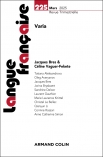
Langue française n° 161 (1/2009)
Pour acheter ce numéro, contactez-nous
Recevez les numéros de l'année en cours et accédez à l'intégralité des articles en ligne.
Sinon est un petit mot boudé des grammairiens, des lexicographes et des linguistes. On ne le trouve en effet traité ni dans la Grammaire Larousse du français contemporain ( GLFC , 1964), ni dans la Wagner & Pinchon (1962), ni dans la Riegel et al. (1994), ni dans la Grammaire textuelle du français de H. Weinrich (1989). Sinon est bien abordé dans d’autres grands ouvrages universitaires de référence comme Le bon usage , la Grammaire du sens et de l’expression de P. Charaudeau (1992) ou la Grammaire critique du français de M. Wilmet (1997), mais il l’est à chaque fois en quelques lignes, voire en quelques mots. Du côté des dictionnaires, Le grand Robert de la langue française est le seul à notre connaissance à traiter de ce morphème de façon un tant soit peu développée.
Lexicographers, linguists and grammarians have paid little attention to the study of the French particle sinon . Yet sinon covers a wide range of at least 7 different meanings to which an eighth can be added when sinon is used to introduce a new topic in a conversation. Here we shall make a study of that conversational sinon and show that this particular use of sinon exhibits the same semantic values of the other 7 usages, but expresses involvement on the part of the speaker. Finally, we shall establish that sinon is a fully grammaticalized particle that can be compared with the Dutch anders , which can be used to express an attitude of the speaker. It is not the case of the French autrement and the English otherwise , which are restricted to the expression of semantic contents and textual links.

